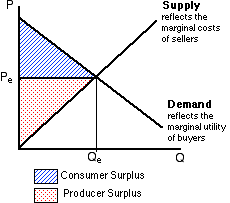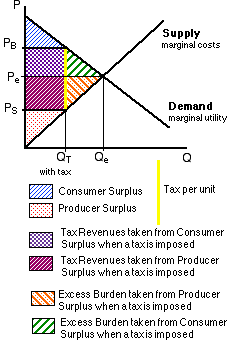1. Taxes can
be avoided by refusing to sell or buy the taxed goods.Thus, taxes
reduce utility and are inefficient.
2. An excise (per unit) tax can be shown as a vertical gap between
the demand curve and the supply curve (Figure
2-2)
3. Price paid by buyer rises while price received by seller falls,
but neither price changes by the full amount of the tax. The
price paid by the buyer rises to PB and the price received by
the seller falls to PS (in Figure 2-2).
4. Quantity traded falls because quantity demanded and quantity
supplied are both lower. The quantity of trade falls to QT in
Figure 2-2.
5. Difference between buyers' price and sellers' price is the
tax per unit .
6. Revenue to government is
(tax per unit) x QT,
or (PB-PS) x QT
This corresponds to the area of the darkest rectangles in Figure
2-2.
7. Part of the tax is paid by buyers out of consumer surplus,
and part is paid by sellers out of producer surplus.
8. Every tax has an excess burden (sometimes called the deadweight
loss). This is the area of the darkly striped triangles in Figure 2-2. This area is
![]()
9. The tax is borne mostly by the group
(buyers or sellers) with the steeper curve (not necessarily the
group who writes the checks). See Figure 3.
10. Excess Burden of a tax is greater if demand or supply curves
are flat. See Figure
3.
Figure 2-1 Gains from Trade At Equilibruim

